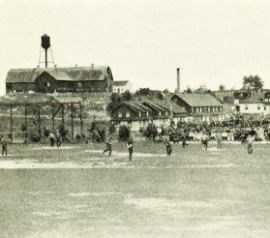NEWS RELEASE
ONTARIO HERITAGE TRUST
********************** Ontario Heritage Trust unveils provincial plaque to commemorate correctional reform institution in Burwash
BURWASH, ON, - Yesterday, the Ontario Heritage Trust, the Ontario Ministry of Community Safety and Correctional Services and the Burwash Alumni Committee unveiled a provincial plaque commemorating Burwash Industrial Farm during the Burwash Alumni Picnic. Industrial farms, such as the one in Burwash, revolutionized the way low-risk inmates served their sentences in Ontario's correctional facilities.
Established in 1914, the Burwash Industrial Farm was one of the largest reform institutions in 20th-century Ontario.
During its peak, it held over 800 minimum- and medium-security offenders and spanned 14,164 hectares (35,000 acres) of owned, and 40,469 hectares (100,000 acres) of leased, land to accommodate the inmates and prison staff families. "Telling Ontario's stories through provincial plaques gives us the opportunity to highlight the important people, places and events in our past that have influenced and shaped us," said The Honourable Lincoln M. Alexander, Chairman of the Ontario Heritage Trust. "The Burwash Industrial Farm offers a heritage snapshot of a time when it was believed that low-risk inmates would benefit from the exercise and skills learned while working outdoors at self-supporting institutions." This self-sustaining facility allowed inmates to grow their own food, tend the crops, develop agricultural techniques and provide food to other provincial institutions.
Over time, the institution also operated a lumbering operation, including a mill and tailor shop that provided clothing for prisoners and shirts for prison officers.
As well, it boasted its own 20-bed hospital, assembly hall, newspaper, entertainment and sports activities.
The nearby Monteith Experimental Farm was annexed as a supplementary site. "Ontario's communities developed for many reasons," said Ontario Minister of Culture Caroline Di Cocco. "The Village of Burwash grew up around a correctional institution and became its own self-sufficient community with over 1,000 prison staff and their families. It remains a significant part of Ontario's heritage." "The roots of our modern correctional service can be found in the achievements of earlier industrial farms such as Burwash," said Community Safety and Correctional Services Minister Monte Kwinter. "Structured, meaningful community-based work was paramount in rehabilitating Burwash offenders and continues to play an important role in reducing recidivism today." In 1975, following changes to correctional practices, the facility closed and the town all but disappeared.
The buildings were torn down in the mid-1980s when the land was transferred to the Department of National Defence.
Although the institution and town no longer exist, the strong community spirit has not been forgotten.
This spirit, sustained by memories of life in a unique environment, is the lasting legacy of Burwash. This unveiling is part of the Trust's Provincial Plaque Program that commemorates significant people, places and events in Ontario's history.
Since 1953, nearly 1,200 of these distinctive blue and gold plaques have been unveiled.
The Ontario Heritage Trust is an agency of the Government of Ontario, dedicated to identifying, preserving, protecting and promoting Ontario's heritage. *********************
